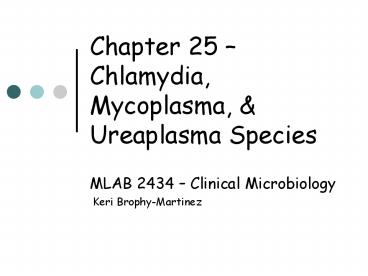Chapter 25 Chlamydia, Mycoplasma, - PowerPoint PPT Presentation
1 / 17
Title:
Chapter 25 Chlamydia, Mycoplasma,
Description:
Replication involves elementary body (EB) and reticulate body (RB) ... Swabs should be of Dacron, polyester or calcium alginate with a plastic or aluminum shaft ... – PowerPoint PPT presentation
Number of Views:196
Avg rating:3.0/5.0
Title: Chapter 25 Chlamydia, Mycoplasma,
1
Chapter 25 Chlamydia, Mycoplasma, Ureaplasma
Species
- MLAB 2434 Clinical Microbiology
- Keri Brophy-Martinez
2
Chlamydia Characteristics
- Unique growth cycle because they are deficient in
independent energy metabolism therefore they are
obligate intracellular parasites - Replication involves elementary body (EB) and
reticulate body (RB) - EBs are infectious, whereas RBs are
noninfectious
3
Life Cycle of Chlamydia
- EB infects host cell by inducing energy-requiring
active phagocytosis - Host cells are nonciliated columnar
epithethelial cells found in tracts of
urogenital, respiratory, rectum and conjunctiva - EB organize into large, reticulating initial
bodies, which divert the cells synthesizing
functions to their own needs and begin to
multiply by binary fission - Organisms begin reorganizing into infective EBs.
- Disrupted host cell dies, releasing new EBs
4
Life Cycle of Chlamydia
5
Chlamydia pneumoniae
- Most recognized species of Chlamydia
- Important respiratory pathogen (acute respiratory
disease, pneumonia, and pharyngitis) - Implicated in asthma
- Risk factor for Guillain-Barre syndrome
6
Chlamydia pneumoniae (contd)
- Common (50 of adults have antibodies)
- College age students most susceptible
- Reinfection common
- Prolonged sore throat and hoarseness, followed by
flu-like lower respiratory symptoms - Can be following by pneumonia and bronchitis
- Third most common respiratory infection
7
Chlamydia pneumoniae (contd)
- If cultured, must be in cells (obligate
intracellular pathogen) and then visualized with
fluorescein-conjugated antibodies - Serologic tests are method of choice for
detection (Four-fold rise in titer)
8
Chlamydia trachomatis
- Most commonly sexually transmitted bacterial
pathogen in U.S. - Only HPV is a more commonly sexually transmitted
disease - Adult males
- Non-gonococcal urethritis (NGU)
- Epididymitis and prostatitis
9
Chlamydia trachomatis (contd)
- Adult females
- Urethritis, follicular cervicitis, endometritis,
proctitis, salpingitis, PID and perihepatitis
(Fitz-Hugh-Curtis syndrome) - Major cause of sterility in U.S.
- May be transmitted to newborns during delivery
10
Chlamydia trachomatis (contd)
- Other sites of infection
- Trachoma infection of the conjunctiva,
resulting in scarring and blindness (Mostly in
India and Egypt) - Lymphogranuloma verereum infects lymph nodes
- STD found in immigrants from the tropics
11
Chlamydia trachomatis (contd)
- Laboratory Diagnosis
- Direct microscopic examination to find EBs
- Cell culture
- Enzyme immunoassay
- Nucleic acid probes with and without
amplification (PCR) - Serologic (antibody) assay
12
Chlamydia psittaci
- Causes psittacosis (parrot fever)
- Identification based on history of close contact
with birds and serologic evaluation
13
Mycoplasma and Ureaplasma Species
- General Characteristics
- Once thought to be viruses because of size
- Mycoplasmas are the smallest free-living organism
in nature - Four human pathogens
- Mycoplasma pneumoniae - respiratory
- Mycoplasma hominis - urogenital
- Ureaplasma urealyticum urogenital
- Ureaplasma parvum- urogenital
14
Mycoplasma and Ureaplasma Species (contd)
- Pleomorphic organisms do not have a cell wall
(resistant to cell-wall-active antibiotics) - Slow growing, highly fastidious, facultative
anaerobes - Require complex media for growth
- Susceptible to heat and drying
- Transmitted via direct sexual contact,
mother-child exposure during delivery or
respiratory secretions
15
Clinical Infections
- Mycoplasma pneumoniae
- Causes bronchitis, pharyngitis, or primary
atypical pneumonia (a.k.a. walking pneumonia) - Usually infects school-age children and young
adults in close quarters (dorms, military
barracks, etc.) - 50 of infections produce cold agglutinins
- Most often diagnosed by serologic evaluation
16
M. hominis Ureaplasma species
- Most often associated with urogenital tract
infections - May be isolated from asymptomatic individuals
- Can be transmitted to the fetus at delivery
- Opportunistic pathogens
17
Laboratory Diagnosis
- Cultures must be delivered immediately to the
lab, because the organisms are very susceptible
to drying - Should be placed in transport media
- Swabs should be of Dacron, polyester or calcium
alginate with a plastic or aluminum shaft - If not plated immediately, should be frozen at
-70C - Most infections detected via serologic evaluation































